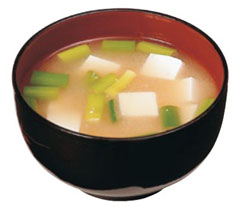 MISO MISO
Miso(味噌) is Japan's traditional seasoning and health food. Made from fermented soybeans mashed into a thick paste, the many health benefits of miso have been well documented in scientific studies. Indeed, recent years have seen miso steadily gain a global reputation as a superbly tasty and versatile health food.
What's MISO?
No traditional Japanese meal is complete without miso. The paste is used as a seasoning for soups and a host of traditional dishes, and has been a key ingredient in healthy diets for centuries. Miso as it was made in the Edo period.
Where does it come from?
Originating in China or the Korean Peninsula, miso found its way into Japan in the 7th century where it was gradually transformed into intrinsically Japanese seasoning.
How is it made?
Miso is made from soybeans, salt and a special mold starter. What's so good about it?
Miso is a healthy, balanced food that does wonders for the body.
And the taste?
Superb! Miso is an all-round seasoning that adds flavor to any type of dish.
※ Miso is pronounced [mee-soh].
Miso through the ages
The method for making miso is believed to have originated from the application of a fermented spice made from ground fish, meat and salt, and a type of fermented soybeans and millet that were brought to Japan from China or the Korean Peninsula in the 7th century. Over the following centuries, the methods for making miso were refined and enhanced, creating a broad spectrum of styles and tastes, a process which still continues today. 
Types of Miso
Miso's fermentation and aging process involves a multitude of factors, the slightest variation of which can result in vastly different tastes, colors and textures. This is reflected in the more than 1300 types of miso that can be found throughout Japan, each with its own distinct flavor. 
The wonders of Miso
The Japanes have long known about miso's remarkable health benefits. Recent research has found that the benefits of miso come not only from the nutrients in the soybeans, but also from other ingredients that arise from the actions of aspergillus and other molds used in the fermentation and aging processes. 
Cooking with Miso
For centuries the typical breakfast for Japanese people was rice and miso soup and waking up to the aroma of miso soup was a quintessential part of Japanese family life. Even today, for many Japanese, the word miso calls to mind images of good old-fashioned home cooking. Although in recent years it has become less common to see miso soup on the breakfast table as Japanese tastes become more Westernized, miso soup still remains an integral part of the Japanese diet.
1. Miso soup(味噌汁):  Tofu & negi miso soup Tofu & negi miso soup  About dashi. About dashi.
2. Western-style miso soups :  Chicken & vegetable miso soup Chicken & vegetable miso soup  Miso clam chowder Miso clam chowder
3. Miso-based dips and spreads:  Miso meat sauce Miso meat sauce Salad with miso mayonnaise Salad with miso mayonnaise Pasta with miso meat sauce Pasta with miso meat sauce Toast with miso butter Toast with miso butter Potatoes with miso mayonnaise. Potatoes with miso mayonnaise.
- from Japan Miso Promotion Board (http://www.miso.or.jp) - |
